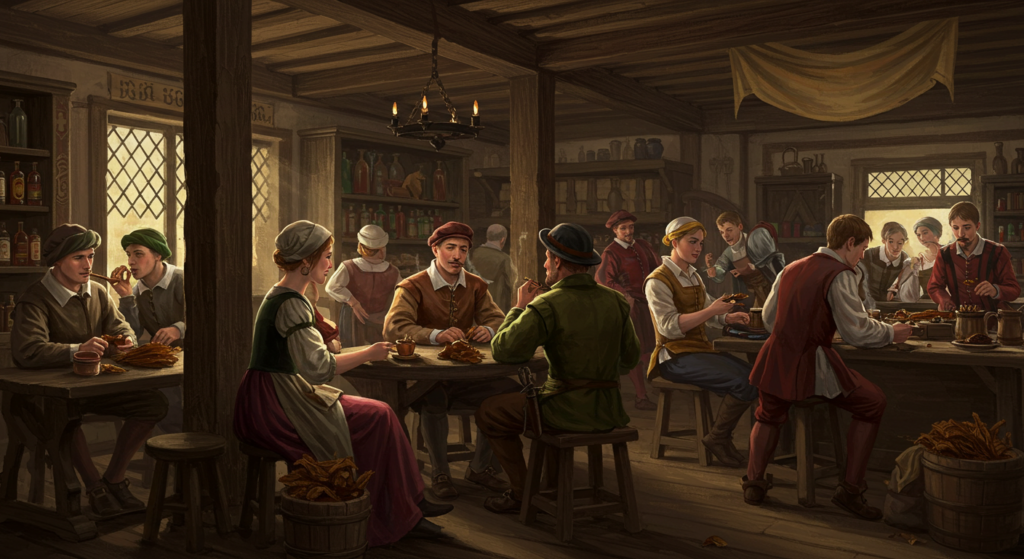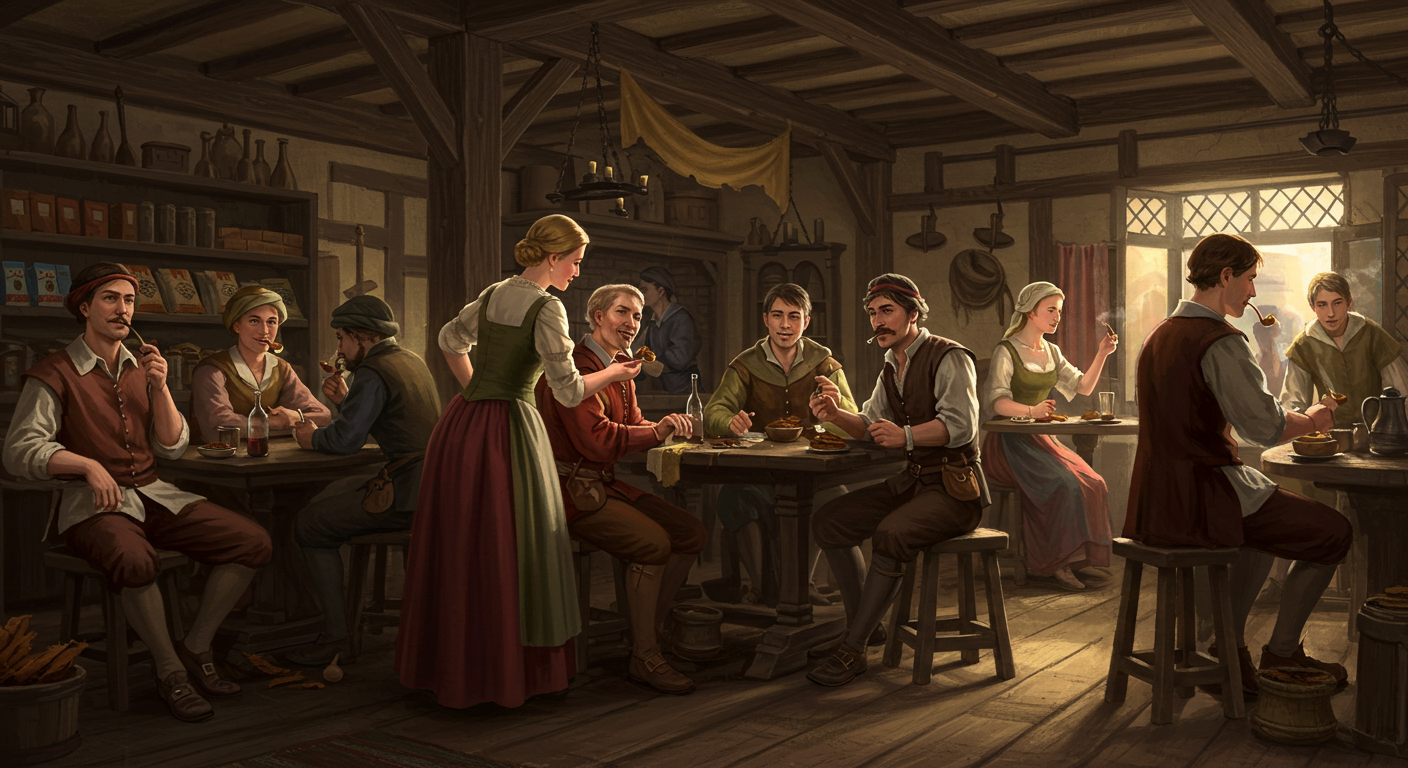The evolution of tobacco smoking in England showcases a remarkable shift in cultural practices. This transformation not only altered individual behaviors but also redefined social norms and interactions within communities. This article delves into its introduction in the late 16th century, showcasing how it evolved into a communal social activity. Tobacco’s journey from skepticism to widespread acceptance highlights its significant impact on English society.
Tobacco’s arrival in medieval England coincided with the return of explorers from the Americas. Nevertheless, influential figures like Sir Walter Raleigh played a crucial role in popularizing tobacco among the nobility. His efforts not only elevated tobacco’s status but also sparked a broader interest in its use across different societal levels. As a result, smoking practices in medieval Europe began to shift, leading to a broader acceptance across various social classes. Moreover, tobacco shops emerged as communal spaces where people gathered to enjoy this new pastime.
With the rise in tobacco’s popularity, it became a social practice that united individuals across different classes. People from different backgrounds began to frequent tobacco shops, fostering a sense of community. This evolution marked a significant cultural shift, as smoking became a shared experience among friends and acquaintances. Such shared experiences often lead to the formation of lasting bonds and community ties that transcend social barriers. Thus, the narrative of tobacco smoking in England uncovers an intriguing evolution of social dynamics and cultural practices.

Discover the Surprising Impact of the History of Tobacco Smoking in England on Social Classes
How did the introduction of tobacco to medieval England transform social interactions and cultural practices? The introduction of tobacco was like opening a door to a new world of social interaction and cultural exchange. This question highlights the significant changes that occurred during this period. Understanding these changes provides insight into the broader implications of tobacco use on social structures and relationships. The late 16th century marked a pivotal moment in English history, as tobacco transitioned from a mere curiosity to a widely accepted substance.
Tobacco was brought to medieval England in the late 16th century, following the explorations of those who discovered it in the Americas. For this reason, the first recorded use of tobacco in England was by Sir Walter Raleigh, who popularized its smoking among the English nobility. Important to realize is that the cultural acceptance of tobacco grew rapidly, leading to its widespread use across different social classes. This rapid acceptance reflects not only changing attitudes towards tobacco but also the evolving nature of social interactions in England. Imagine a time when the nobility and commoners alike gathered to share a smoke, breaking down the walls of class distinction.
People from various backgrounds began to frequent tobacco shops, which served as communal spaces for interaction. Tobacco shops were the medieval equivalent of today’s coffee houses, buzzing with conversation and camaraderie. This shift in smoking practices in medieval Europe fostered a sense of community among users. Furthermore, the social aspect of tobacco use contributed to its acceptance across different demographics. This acceptance was crucial in shaping the cultural landscape of the time, as it allowed for greater social integration among diverse groups. In particular, the history of tobacco smoking in England illustrates a complex interplay between culture and community.
In addition to its social implications, tobacco also influenced economic activities. The rise of tobacco shops created new business opportunities, contributing to local economies. The economic boom from tobacco was like a breath of fresh air for local economies, invigorating trade and commerce. It is evident that the demand for tobacco products led to the establishment of trade routes and cultivation practices. These economic developments not only fueled the tobacco industry but also had lasting effects on local economies and trade relationships. Just as tobacco transformed social interactions, it also sparked a revolution in economic practices, creating a buzz that resonated through the markets. Lastly, the evolving perceptions of tobacco reflected broader changes in health awareness and social norms.
Why Smoking Practices In Medieval Europe Created Lasting Bonds
The development of tobacco smoking in England highlights its transformation into a shared activity that built social ties, especially in the early 17th century with the rise of tobacco shops. The rise of tobacco shops was akin to the birth of a new social scene, where everyone was welcome to join the conversation. This transformation marked a significant cultural shift, as tobacco became more than just a product; it became a social catalyst. The vibrant atmosphere of these shops encouraged interactions among diverse groups of people. Such interactions were pivotal in breaking down social barriers and fostering a sense of community among patrons.
It is evident that the practice of smoking tobacco became associated with social gatherings and leisure activities, similar to modern practices in lounges like Aria Lounge. Tobacco smoking evolved into a communal activity, fostering social connections among users. To explain further, the early 17th century saw the establishment of tobacco shops, which became popular venues for smoking and socializing.
These shops provided a space where individuals from various backgrounds could come together. Picture a lively gathering where stories were exchanged as freely as the smoke wafted through the air. People shared stories, laughter, and experiences while enjoying their tobacco. Therefore, the history of tobacco smoking in England reflects a significant cultural shift influenced by exploration and trade. This shift not only transformed individual habits but also redefined the social fabric of the time, illustrating the power of cultural exchange.
Additionally, the rise of tobacco shops contributed to the economy, creating jobs and stimulating local commerce. As tobacco gained popularity, it became a staple in social interactions, shaping the way people connected. This transformation in social practices underscores the importance of communal activities in fostering relationships and building networks. This evolution in smoking practices in medieval Europe laid the groundwork for future cultural trends surrounding tobacco use.
Lastly, the communal aspect of tobacco smoking established a sense of belonging among users. The shared experience of enjoying tobacco fostered friendships and connections that transcended social classes. The communal experience of smoking was like a bridge, connecting people from all walks of life. This dynamic illustrates how tobacco smoking not only influenced individual habits but also shaped societal norms and interactions.

The Evolution of Tobacco Smoking in England Unveils a Rich Social Legacy
The history of tobacco smoking in England reflects a significant cultural shift influenced by exploration and trade. This journey began with the introduction of tobacco to medieval England in the late 16th century, which marked a significant cultural shift. Initially, tobacco was a curiosity, but it quickly became a widely accepted substance among various social classes.
As smoking practices in medieval Europe evolved, tobacco transitioned into a communal activity. During the early 17th century, tobacco shops emerged as popular venues for socializing. These shops fostered connections among individuals, creating a vibrant social atmosphere. What’s more, tobacco smoking became more than just a habit; it became a cultural phenomenon that united people from different backgrounds.
In conclusion, the history of tobacco smoking in England illustrates its profound impact on society. The acceptance of tobacco transformed social interactions and created new communal spaces. All in all, this evolution reflects the dynamic nature of cultural practices and their ability to shape social connections over time. The introduction of tobacco to medieval England sparked not just a trend, but a lasting legacy. As smoking practices in medieval Europe transformed, they shaped social interactions in ways that still resonate today. So long as people gather to share stories and experiences, the spirit of those early tobacco shops lives on.
Listen to an AI-Generated Podcast of this Blog
Unveiling the Social Secrets of Tobacco in Medieval England
Prepare to discover a fascinating random fact about tobacco smoking in medieval England. The introduction of tobacco to medieval England sparked a cultural revolution. Without doubt, it transformed social interactions among various classes. Initially, tobacco was a curiosity, but it quickly gained popularity. Smoking practices in medieval Europe evolved significantly during this time. On the positive side, tobacco shops emerged as communal spaces for socializing. People from different backgrounds gathered in these shops, fostering connections. By the same token, these interactions broke down social barriers. Not only did tobacco create a shared experience, but it also shaped societal norms. All things considered, the legacy of tobacco smoking continues to influence social practices today. This cultural phenomenon illustrates the power of shared experiences in building community ties.
FAQs
What was the introduction of tobacco to medieval England like?
The introduction of tobacco to medieval England occurred in the late 16th century. It marked a significant cultural shift.
How did Sir Walter Raleigh influence tobacco smoking?
Sir Walter Raleigh popularized tobacco among the English nobility. His efforts elevated tobacco’s status in society.
What role did tobacco shops play in social interactions?
Tobacco shops became communal spaces for socializing. They fostered connections among individuals from different backgrounds.
How did smoking practices in medieval Europe evolve?
Smoking practices in medieval Europe evolved into a communal activity. This transformation marked a significant cultural shift in society.
What impact did tobacco have on social classes?
Tobacco united individuals across different classes. It broke down social barriers and fostered a sense of community.
How did tobacco influence economic activities?
The rise of tobacco shops created new business opportunities. This invigorated local economies and stimulated trade and commerce.
What was the significance of communal smoking experiences?
Communal smoking experiences fostered friendships and connections. They transcended social classes and built lasting bonds among users.
How did tobacco smoking reflect changing social norms?
Tobacco smoking reflected evolving attitudes towards social interactions. It illustrated the dynamic nature of cultural practices over time.
What legacy did the history of tobacco smoking in England leave?
The history of tobacco smoking in England created a lasting legacy. It transformed social interactions and shaped community ties.
How did the acceptance of tobacco affect social integration?
The acceptance of tobacco allowed for greater social integration. It united diverse groups and reshaped the cultural landscape.
Come Visit Us
We have three fantastic locations we’d love to invite you to! If you’re in the Chicagoland area, you can come chill with us at either our Grayslake or Schaumburg locations. Alternatively, if you’re in Wisconsin, stop by and visit us at our Kenosha lounge. Please note that you must be 21+ to enter with a valid ID. We hope to see you soon!


